The old priest at Saint-Quentin was not an important man in the reckoning of the world. His church was small and unimpressive; only a fairly detailed map showed the village of Saint-Quentin, which was south of Tours, in the Indre-et-Loire. His cassock had seen much better days; he had been a fat man, but now the skin hung loosely under his chin. He was a parish priest of no renown, caring quietly and compassionately for his people. His curing of souls was a leisurely affair; he did not display particular zeal. He lived in a wine district and enjoyed a good bottle over which he would ruminate, without anguish, upon the sins and follies of humanity.
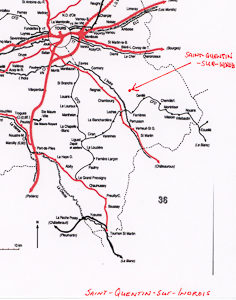
Did You Know?
This is a story told by Philippe de Vomécourt (1902−1964) in his book, An Army of Amateurs. It is just one of thousands of stories about nameless men, women, and children who risked their lives to save downed Allied airmen, Jews, and others from the grasp of the Nazis. Although this story took place in France, stories like it were repeated in all of the occupied countries and even those that were considered “neutral.” These brave people knew the ultimate penalty if they were caught but went ahead because it was the right thing to do. Monsieur de Vomécourt was one of the first leaders of the Special Operations Executive (SOE) F Section. He along with his two brothers, Pierre and Jean, established a réseau (network) in three separate territories of France, including Paris. We first met the Vomécourt brothers in our blog about La Chatte (click here to read the blog).
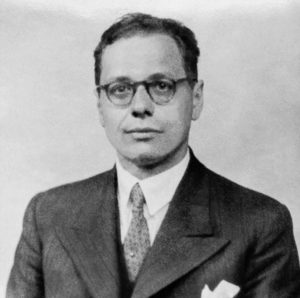
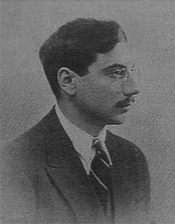
But the accident of war placed the village of Saint-Quentin just on the northern side of the demarcation line (later, the line was to be redrawn, placing Saint-Quentin in the free zone). The German patrols crunched through the streets. And the old cure, who could have lived out his days pottering about his parish, innocent of involvement in the war, saw a duty that he must perform. He must help people to cross the demarcation line, especially those whose lives were in peril. He must help the Jews; he must help escaping prisoners-of-war and airmen who had been shot down, all who were seeking to evade the Germans.
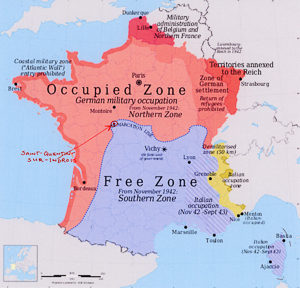
His church was a temporary sanctuary; it was also like a departure platform for conducted tours across the line. All he asked of the people he helped was that they should give him a bottle or two of good-quality red wine; it was not difficult for them to get hold of what he wanted in his district.
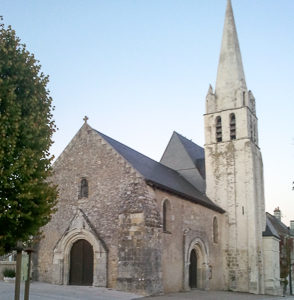
The old priest took great satisfaction in his work.
“I’m doing good to everyone,” he used to say. “First, I ask the people to give me the two bottles of good wine. Right. Then I tell them the time they must come to see me, and when they come I ask them to wait in the church. Now, some of them, when they get into church, feel a bit awkward. They don’t know how to pray. Some are arrogant and don’t even want to pray. But there they are in the church. They dare not leave until I tell them, and so they walk round and round. Their shoes make an awful noise, echoing on the stone floors. They begin to feel self-conscious, especially if other people are kneeling and praying. So, in the end, they too get down on their knees and try to remember the old prayers they learned as children. They probably try to hide behind a pillar, but that doesn’t matter. They ask God to help them across the line of demarcation. God is satisfied. He’s got a new client, someone else who has come back to Him. Fear is a very spiritual thing, because it reminds people of how helpless they are and how dependent on God.”
The cure waited for the sound of the German patrol. When he heard them coming, he went out onto the doorstep of his church and called to them.
“Hello, over there. How are you? It’s awfully hot, isn’t it? Why don’t you come in and have a drink?”
He took the German soldiers into his presbytery and opened a bottle of his good wine. The Germans mopped their faces and relaxed with him.
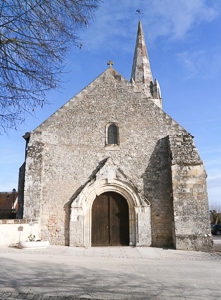
“The Germans are satisfied as well,” said the cure, continuing the explanation of his methods. “They get their drink, I am satisfied because I get more people to come back to God—and because I’m also having a good drink.”
Always with the cure at these times was a little boy, an orphan whom the priest had brought up. As soon as the Germans were filing into his presbytery, the cure winked at the boy, who went into the church and whispered to the people waiting there, “Come on, quick. This is your chance. Follow me.”
The boy led them to the demarcation line, walked straight across to the other side with them, showed them the route to follow from there, and came back to the church. He went to the cure, winked, and the old priest knew all was well.
“Ah, well, that was very pleasant,” he said to the Germans, wiping his lips. “But I think we’ve drunk enough. It’s time you went on with your patrol, don’t you think?” And the Germans trooped out again, the cure following them, his rosy, round face benignly composed as he said good-bye to them.
The invitation to the German patrol to take a drink with him became something of a ritual. The cure’s simple method of helping people cross into the free zone worked for a very long time, and there seemed no reason why he should ever be suspected. Then one day a man came to him, as hundreds had come to him before, telling a pathetic and appealing story.
“I come from Paris,” he told the priest. “My wife is a Jew and the Germans have taken her and our children away. I was out at work, and when I came home I saw them being pushed into a lorry. I’m afraid they’ll come for me next, and I want to get to England so that I can join General de Gaulle and fight the devils who took my family from me.”
The cure told him when to return to the church. There, as usual, he joined a group of people waiting to cross the line. The soldiers came for a drink, the cure winked at the little boy, who led his party to the demarcation line. They were on their way across, when the “man from Paris” stopped them. He drew a gun and, there and then, shot them all, including the boy. Then the man, who was a German, went back to the church. He took the patrol of German soldiers with him. He dragged the priest out. At his order, the soldiers shot down the old cure at the entrance to his church.
That priest died a worthy death. He had helped hundreds to escape from the Germans. He did his duty as a priest, his duty to God, and his duty as a Frenchman.
Author’s note –this is an excerpt from Philippe de Vomécourt’s book, An Army of Amateurs. Permission to reprint this chapter was requested months ago from Doubleday.
Recommended Reading
Vomécourt, Philippe de. An Army of Amateurs. Garden City: Doubleday & Company, Inc., 1961.
This is one of those books I’ve commented on before (see my blogs on Etta Shiber— “I was Looking Forward to a Quiet Old Age” [click here] and Marie-Madeleine Fourcade—”Noah’s Ark” [click here]). It’s written as a first-hand account of the events experienced by the author. In an age when historical novels are so popular, it’s refreshing to read actual historical accounts authored by the participant.
Garby-Czerniawski, Roman. The Big Network. London: George Ronald, 1961.
While this book has nothing to do with this week’s blog, it does for a previous blog: La Chatte (click here). Like Vomécourt, The Big Network was written by one of the major participants from a first-hand perspective of events. Notice that both books were written in 1961. Both authors were involved with various intelligence agencies and covert operations. Therefore, they were limited in what they could divulge. Garby-Czerniawski worked for British intelligence and was silenced by the Official Secrets Act. This is the reason why Garby-Czerniawski’s book does not discuss his role in Operation Double-Cross.
What’s New With Sandy and Stew?
I mentioned in our last blog that I would introduce you to several tour guides from our trip around the British Isles. As many of our long-time readers know, Sandy and I are big fans of hiring private tour guides. We do this both when we want a general overview of an area we visit (e.g., Liverpool and Dublin) as well as tour specific topics (i.e., Londinium and Versailles and the French Revolution). The cost differential is minimal and you get so much more out these walking tours than you do in a group situation. Over the years you’ve heard us extol the talents of Raphaëlle Crevet (raphaellecrevet@yahoo.fr) who is our “go-to” guide in and around Paris. Now, let me introduce you to the folks you’ll want to hire for your visit to Dublin and Liverpool.
Tess Pike was our guide in Liverpool and Garvan Rushe took us around Dublin. Each did a spectacular job of framing their respective city around world history and specifically, in the context of England and Ireland. Each was unique in their approach and I’d like to especially thank Garvan for teaching me the “proper” way of drinking a glass of Guinness beer. While everyone else was out chasing the Beatles, Tess gave us a much broader and informative visit to her city. We have found that the top guides ooze with an exuberance for their city and topics. Tess and Garvan met that test with flying colors. Here is how you can reach them:
Tess Pike
Tours by Locals
Guide_17804-229@toursbylocals.com
+ 11447778145156
Garvan Rushe
Viator Tour Guides
Garvan.rushe@gmail.com
+ 353 86 30 444 33
So, when you’re next in Liverpool and/or Dublin, do not hesitate to contact our new friends and let them know you want a tour like they gave to Sandy and Stew Ross.
Someone Is Commenting On Our Blogs
Thank you to Nancy Staub for her kind comments about our blogs. Nancy is the director for the Renaissance Academy—Florida Gulf Coast University. I recently gave a two-hour seminar presentation on self-publishing and have been asked to come back and do presentations on some of the blog topics. So, I put together a list of ten potential topics and submitted these to Nancy. Some of the topics are AmazingWomen of the French Resistance, Rendezvous with the Gestapo, Dead People and a Dog: Walks Through Curious Paris Cemeteries, and Marie Antoinette’s Last Ride. Perhaps you are familiar with these? If not, go to our web site, www.stewross.com, and click on “Blog Index” at the top menu bar. You’ll find each and every blog we’ve posted.
If there is a topic you’d like to see a blog written about, please don’t hesitate to contact me. I love hearing from you so keep those comments coming.
Why Would You Want To Buy Our “Walks Through History” Books?
Simple.
You like to travel and experience history and historical events. You like to see original buildings that had a significant impact on the people and events of the history you’re engaged with. You want to know the stories behind the brick and mortar in front of you.
The walking tour books are meticulously researched so you can go directly to those sites and learn about the building’s history as well as an introduction to some of the more interesting people associated with it.
Thank You
Sandy and I appreciate you visiting with us. We have some exciting things on the horizon and we’ll keep you updated as we go along.
Share This:
Follow Stew:
Find Stew’s books on Amazon and iBooks.
Please note that we do not and will not take compensation from individuals or companies mentioned or promoted in the blogs.
Walks Through History
Copyright © 2018 Stew Ross


